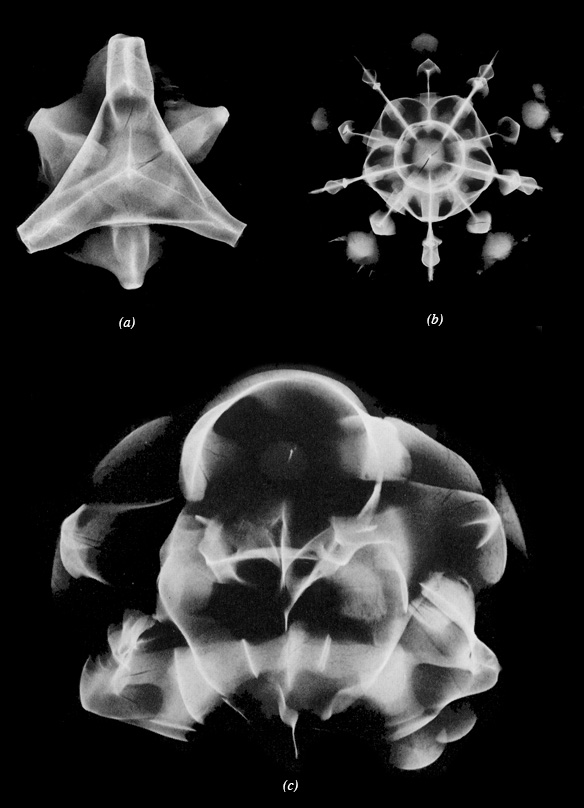The wave is not the water. The water merely told us about the wave moving by.
In the 1960’s, the Swiss scientist Hans Jenny conducted a series of experiments to investigate how physical matter responds when irradiated with sound. The photographs which follow show the results of some of these experiments. He called this field of research Cymatics (from the Greek, kyma - the wave, ta kymatika - matters pertaining the waves, wave matters).
Jenny was not the first to undertake such research: Galileo claimed that when he rubbed the rim of a glass of water producing a tone, highly complex symmetrical figures appeared in the water. Similarly Robert Hooke, when not dissecting dogs in improbable manners or redesigning the ground plan of London, experimented with sonic vibrations. Jenny’s most celebrated precursor, Ernst Chladni, produced sonorous figures by bowing metal plates strewn with sand - the sand traced the nodal lines of the vibrating plate.
However, as far as I know, Jenny’s research is the most extensive and systematic so far undertaken. According to Dr. Peter Guy Manners, who helped Jenny with his research and was an expert in vibrational medicine, the wealth of vibrational forms were produced by relatively simple experimental method. The various media were vibrated with simple sine waves, produced by a function generator and fed to a piezo-electric transducer, a crystal oscillator, which was attached to receptacles containing the different vibrated substances. Thus, when a metal plate strewn with quartz sand was vibrated with a frequency of 8200 Hz, the patterning shown in figure 56 appears.

Figure 56
When the frequency of the input signal is increased the constituent elements of the harmonic figures become more complex. This is not a gradual process of evolvement but a periodic shift between different states. In natural acoustics we saw that the overtone series jumps from one partial to another in a periodic fashion; so here, the change from one symmetrical pattern to the next is always abrupt.
We are not dealing, however, with a simple correspondance between tone and the harmonic patterning of cymatic phenomena. For the frequency of the generating tone is not the only defining variable in these experiments - the amplitude of the tone has an equal bearing on the process as does the physical characteristics of the different vibrated media.
The patterning of sand in figure 56 was produced by high frequency irradiation, whereas both the tracery of water (figure 57) and the pentagonal formation of a pulsating drop of water (figure 58) were created by frequencies below 200 Hz.

| Figure 57 | Figure 58 |
Furthermore, we should bear in mind that cymatic phenomena are not static two-dimensional forms on the surface of the vibrating medium but rather dynamic wave processes. Film of Jenny’s experiments shows how moving currents circulate throughout vibrating liquid media and how drops pulsate rhythmically under the influence of sound. That we are dealing with three-dimensional phenomena is highlighted by the form shown in figure 54, which is a vibrated mass of kaolin paste. Likewise, sound can be seen to pattern gaseous media in three-dimensional space (figure 60).

Figure 59

Figure 60
So far we have only considered the effect of single frequencies upon matter. My aim is to expand Jenny’s field of enquiry and investigate the bearing of musical consonance on cymatic structuring.
Figure 61
There is a bewildering leap of complexity from the patterns created by single sine waves to those produced by polyphonic sound. Figure 61 shows a film of water vibrated by orchestral sound (Mozart’s Jupiter Symphony). We perceive these patternings as textures rather than geometric forms. Clearly, to understand the structural principles of cymatic polyphony we need to simplify the tonal input.
If two sine waves whose frequencies are related by a simple number ratio are fed into an oscilloscope in such a way that the harmonic motion of one tone is perpendicular to the other, the electron beam traces symmetrical shapes known as Lissajous figures. The figures produced by the simple number consonances of the Lambdoma are shown in figure 57. Here, finally, we encounter a visual, geometric counterpart to musical consonance in the physical realm. How these consonances are manifest in the more complex symmetries of cymatic phenomena is the problem which confronts the research worker.

Figure 62
Hans Jenny showed how two frequencies, creating two distinct symmetrical patterns on a liquid medium, can be combined to produce a third figure. So, in figure 51, when the two frequencies which produce (a) and (b) act together on the liquid film, a resultant form (c) emerges. Clearly these phenomena call for a fuller investigation from the perspective of Harmonicism.

Figure 63